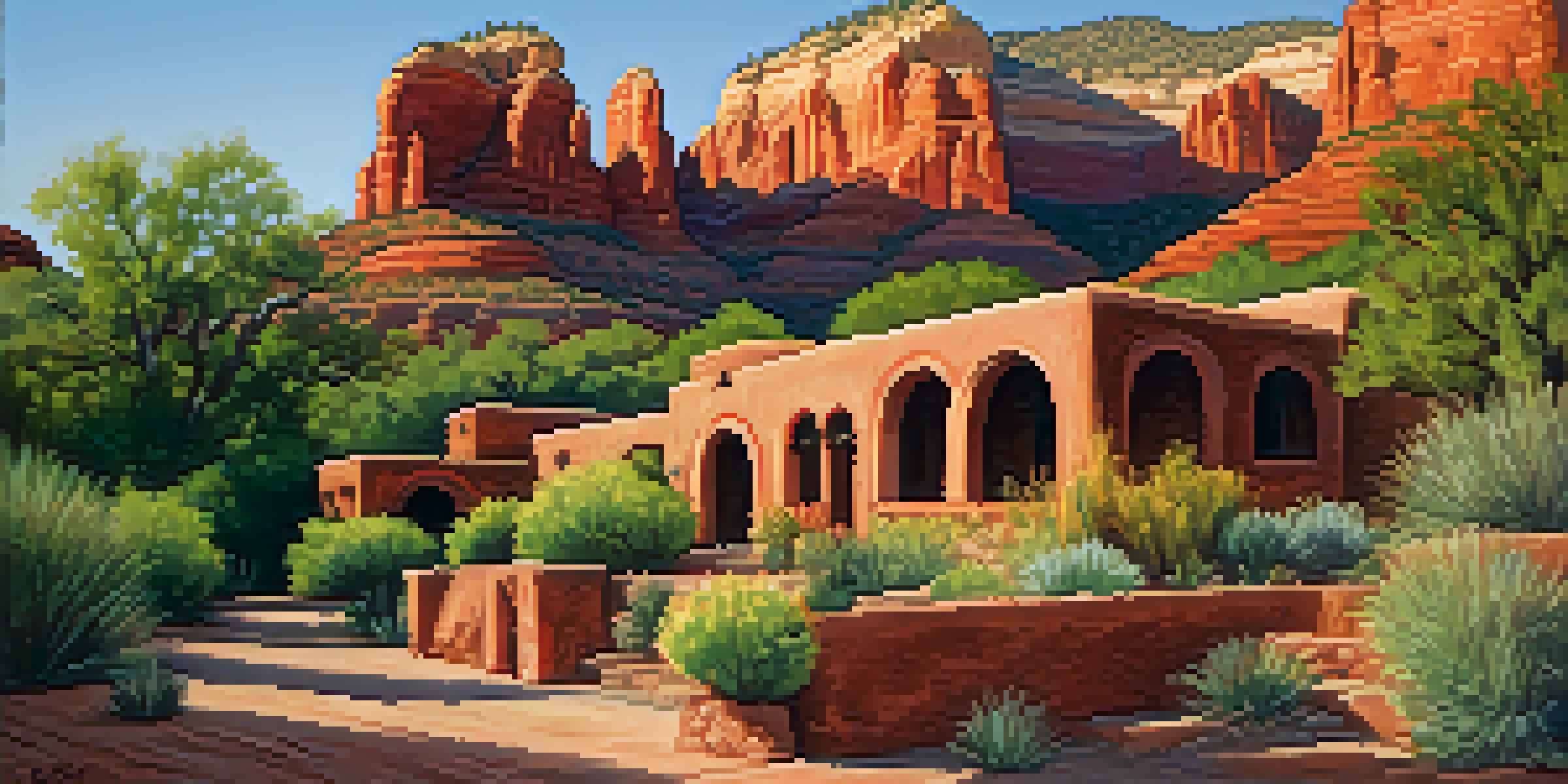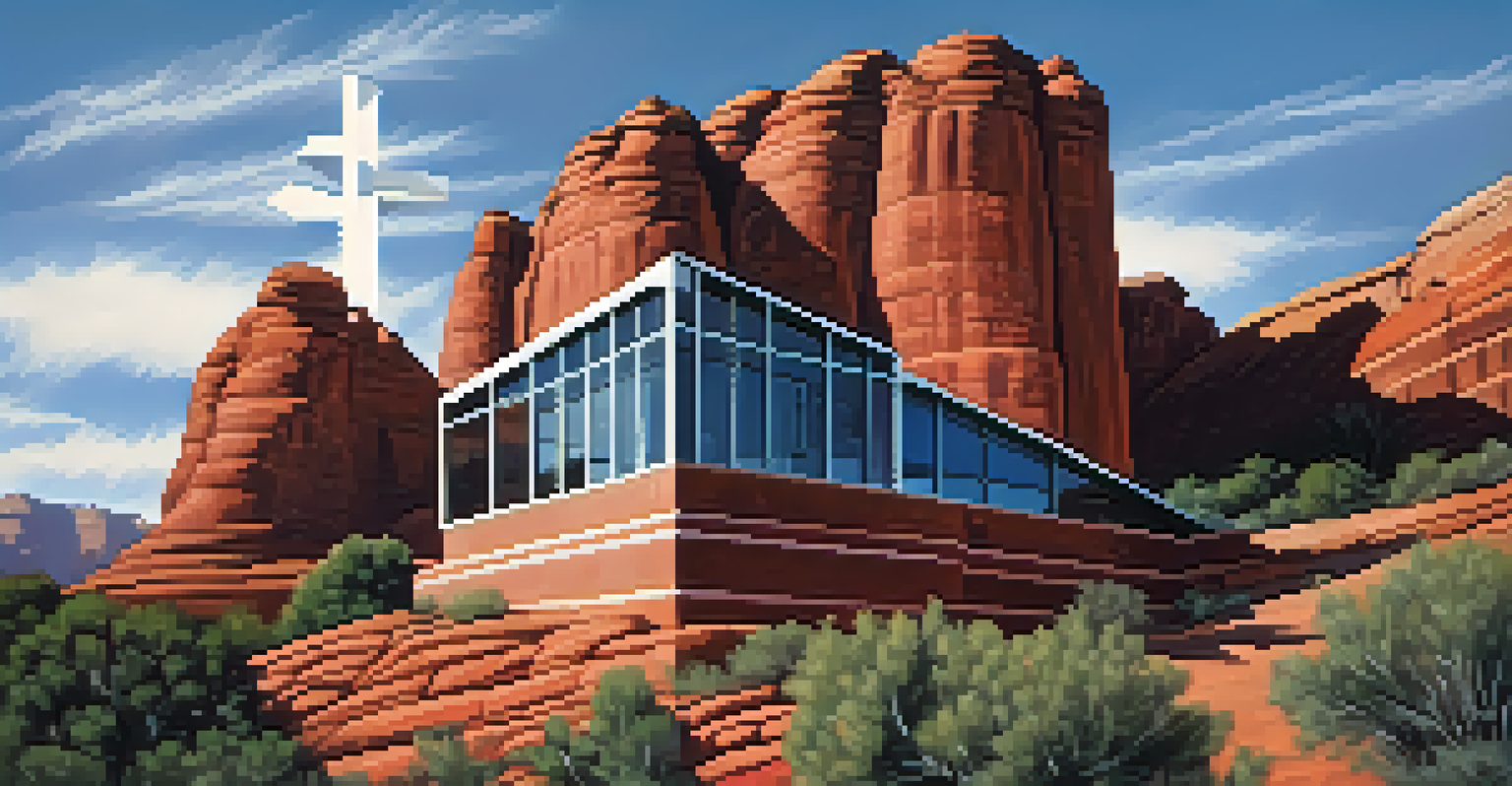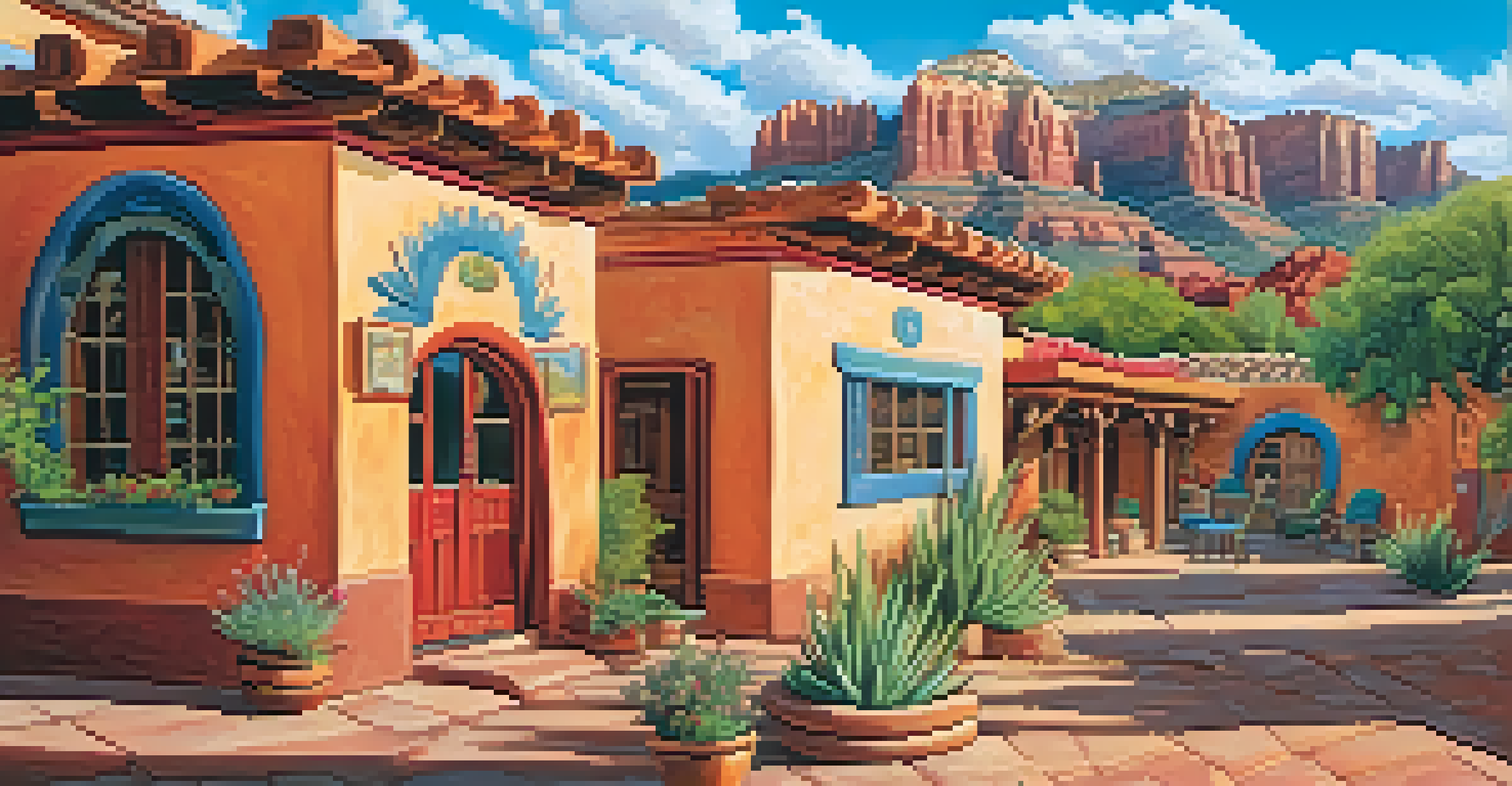The Architecture of Sedona: A Blend of Cultures and Eras

A Historical Overview of Sedona's Architecture
Sedona's architecture is a rich tapestry woven from various cultural influences and historical eras. From Native American dwellings to modern eco-friendly homes, each structure tells a story of the land and its people. The town's history dates back thousands of years, with indigenous tribes, like the Sinagua, leaving their mark through cliff dwellings and adobe structures.
Architecture should speak of its time and place, but yearn for timelessness.
As settlers arrived in the 19th century, they brought with them different architectural styles, including the rustic charm of log cabins and the ornate details of Victorian homes. This blend of styles began to shape Sedona’s unique character, creating an environment that feels both timeless and welcoming. The natural beauty of the red rocks and canyons provided a stunning backdrop for these diverse architectural expressions.
Today, Sedona's architectural landscape continues to evolve, reflecting the community's commitment to preserving its rich history while embracing modern design. This ongoing evolution highlights the town's ability to adapt and thrive, making Sedona a living museum of architectural history.
Native American Influence on Sedona's Structures
The architecture of Sedona is deeply rooted in the traditions of Native American cultures, particularly those of the Sinagua and Hopi tribes. Their influence can be seen in structures that harmoniously blend with the surrounding landscape, using materials sourced from the local environment. Adobe homes, for instance, not only reflect their cultural identity but also demonstrate their understanding of sustainable living.

These early inhabitants built homes that were not just functional but also spiritually significant, often aligning with celestial events and natural features. The cliff dwellings found in the nearby canyons serve as a testament to their ingenuity and adaptability. They utilized the natural terrain for protection and incorporated cultural symbols into their architectural designs, creating spaces that were both sacred and practical.
Sedona's Rich Architectural Heritage
The architecture of Sedona reflects a blend of Native American, Spanish, and modern influences, creating a unique cultural tapestry.
Today, the influence of Native American architecture is celebrated in Sedona, with many modern buildings paying homage to these ancient designs. This connection to the past fosters a sense of respect and appreciation for the original inhabitants, ensuring that their legacy continues to thrive in contemporary architecture.
Spanish and Mexican Architectural Heritage
The arrival of Spanish settlers in the 16th century introduced new architectural styles to Sedona, characterized by adobe structures and vibrant tilework. These elements brought a distinct Mediterranean flair to the area, creating a fusion of cultures that is evident in many of the town’s buildings today. The use of arched doorways, stucco exteriors, and red-tiled roofs became hallmarks of this architectural influence.
Sustainability is about ecology, economy, and equity.
As Mexican culture further permeated the region, it enriched the architectural landscape with colorful murals and wrought-iron details. This combination of Spanish and Mexican styles created a unique visual identity that resonates with the warm, inviting spirit of Sedona. Traditional haciendas and plazas serve as reminders of this historical connection, where community and culture intertwine.
Modern architects in Sedona often draw inspiration from these rich traditions, integrating them into contemporary designs while maintaining a sense of place. This blend of old and new not only enhances the aesthetic appeal of the town but also honors its cultural heritage, making Sedona a vibrant place to live and visit.
The Influence of Arts and Crafts Movement
In the early 20th century, the Arts and Crafts movement made its way to Sedona, emphasizing craftsmanship and the use of natural materials. This movement sought to counter the industrialization of architecture, promoting designs that celebrated individuality and artistry. Many of Sedona's homes from this era feature hand-crafted details, including stonework and wooden beams, reflecting a deep connection to the surrounding landscape.
Architects and builders of this time embraced local materials, ensuring that their designs blended seamlessly with the red rock formations. This approach not only created visually stunning structures but also fostered a sense of harmony with nature. The legacy of the Arts and Crafts movement can still be seen in Sedona's architecture, where each building tells a story of creativity and conscientious design.
Focus on Sustainable Design
Contemporary architecture in Sedona prioritizes eco-friendly practices, integrating modern technology with traditional building methods.
Today, many contemporary architects in Sedona continue to draw from these principles, striving to create homes and public spaces that honor both the environment and the community. This ongoing influence underscores the importance of craftsmanship and the desire to create spaces that resonate with the natural beauty of the area.
Modern Sustainable Architecture in Sedona
As awareness of environmental issues has grown, Sedona has become a hub for sustainable architecture that respects the land and its resources. Modern builders are increasingly focusing on eco-friendly materials, energy-efficient designs, and minimal impact on the natural landscape. This shift not only addresses the pressing concerns of climate change but also reflects the community's commitment to preserving the stunning surroundings.
Architectural styles today often incorporate large windows, natural ventilation, and solar panels, allowing homes to coexist harmoniously with their environment. The use of local stone and wood not only reduces carbon footprints but also pays homage to the traditional building methods of the area's indigenous people. This merging of modern technology with historical context creates a unique architectural narrative that is distinctly Sedona.
Moreover, the emphasis on sustainability has attracted a new wave of residents and visitors who value eco-conscious living. As Sedona continues to evolve, its architecture stands as a testament to the balance between innovation and tradition, ensuring that future generations can enjoy its breathtaking landscapes.
The Role of Community in Shaping Architecture
The architectural landscape of Sedona has been significantly shaped by the community's values and aspirations. Local residents and stakeholders actively engage in discussions about development, ensuring that new projects align with the town's unique character and natural beauty. This collaborative approach fosters a sense of ownership and pride, allowing the community to preserve its identity amidst growth.
Community input has led to the establishment of guidelines that prioritize architectural harmony and sustainability. New developments often reflect the style and materials of existing structures, creating a cohesive aesthetic that enhances the town's charm. This dedication to preserving Sedona's unique architectural identity is a testament to the residents' commitment to their home.
Community's Role in Architecture
Local residents actively shape Sedona's architectural landscape, ensuring new developments align with the town's character and values.
Furthermore, local artists and craftsmen contribute their talents to the architectural scene, enriching the town with their creativity. Murals, sculptures, and decorative elements add a layer of cultural significance to the structures, making Sedona not just a destination but a living canvas of collaborative expression.
Architectural Landmarks and Their Significance
Sedona is home to several architectural landmarks that embody its rich cultural tapestry and historical significance. Structures like the Chapel of the Holy Cross, built into the red rocks, serve as iconic symbols of the town's unique blend of spirituality and artistry. This remarkable chapel not only showcases stunning architecture but also offers breathtaking views of the surrounding landscape, drawing visitors from all over the world.
Another notable landmark is the Tlaquepaque Arts and Crafts Village, designed to resemble a traditional Mexican village. Its charming courtyards and vibrant art galleries reflect the community's commitment to supporting local artists and preserving cultural heritage. This blend of architecture and art creates a lively atmosphere that invites exploration and appreciation.

These landmarks serve as a reminder of Sedona's diverse influences and the stories that have shaped its architectural identity. They stand as testaments to the town's commitment to preserving its history while fostering a vibrant future, making Sedona a truly unique place to explore and experience.
Future Directions in Sedona's Architectural Landscape
As Sedona continues to grow and evolve, its architectural landscape will likely reflect the changing needs and values of its residents. The emphasis on sustainability and community engagement will remain at the forefront of architectural discussions, ensuring that new developments honor the town's rich history while embracing modern innovations. This balance will be crucial in maintaining Sedona's unique character amidst the pressures of growth.
Architects and planners are increasingly looking to integrate smart technologies that enhance energy efficiency and improve the quality of life for residents. This focus on smart design not only addresses contemporary challenges but also aligns with the town's commitment to sustainability. By incorporating these technologies, Sedona can remain a model for environmentally conscious living.
Ultimately, the future of Sedona's architecture will depend on the collaboration between the community, architects, and local government. By fostering a spirit of cooperation and respect for the land, Sedona can continue to thrive as a destination that honors its past while looking confidently toward the future.